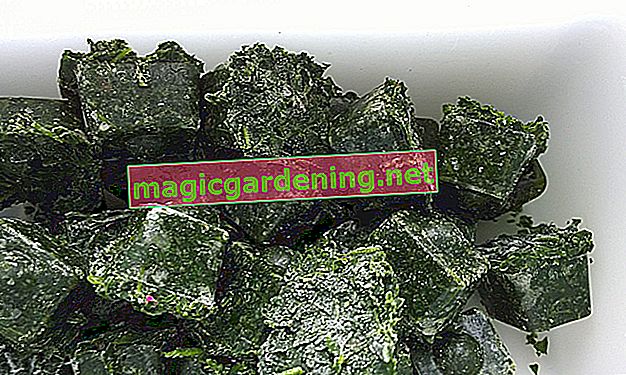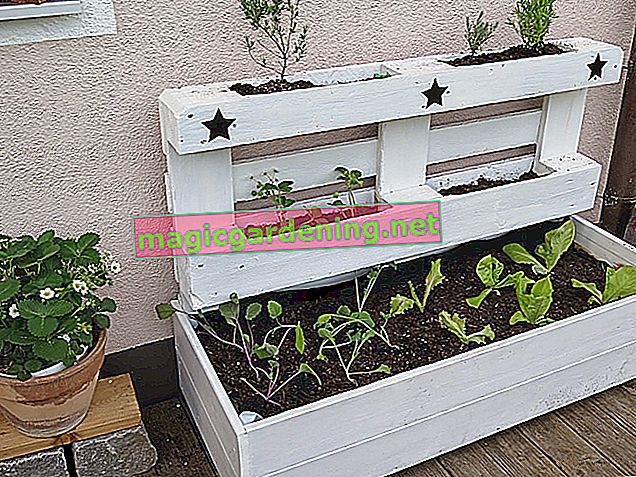
Many amateur gardeners have a passion for collecting rhododendrons. Because the joy of successfully creating two or more plants from one plant is fun. Most rhododendron varieties can be propagated by grafting them. Propagation by cuttings is only recommended for certain types of rhododendron.
also read
- Rhododendron offshoots - multiplication made easy
- Lovage - propagation made easy
- Dividing and propagating rhubarb made easy
The 7 most common propagation practices at a glance:
- sowing
- Offshoot
- Mossing
- Lowerers
- Graft
- Cuttings
- Refining
Increase by sowing - a long game of patience
Germable seed pods are much more voluminous than unfertilized ones. The fresher the seed, the easier it is to germinate and multiply. Embedded in a peat substrate with sand and perlite (€ 32.90 at Amazon *), the seeds germinate in the greenhouse after 4-6 weeks, depending on the rhododendron species.
But only after a year are you spoiled for choice. Then you can prick out the tender green and accelerate the growth with careful fertilization. The first flower buds form after 2 years at the earliest. How long you have to wait eagerly ...
Rhododendrons multiply by cuttings
After flowering is the best time to cut offshoots. Older rhododendrons with side shoots close to the ground are best suited for this. Select a side shoot and cut the bark about six inches below the leaf whisk with a sharp knife. Now you'll put a match in the notch to keep it open. The cut forms wound tissue (callus). New roots will grow from this next spring. Now carefully separate the new plant from the mother plant without damaging the roots. You plant the newly acquired offshoot in a partially shaded place and water it vigorously.
Mossing, lowering or grafting ideal for clones
You just want to clone a duplicate of your rhododendron? This can be done by peeling, lowering or grafting. When mossing and lowering, you cut a young twig close to the ground at an angle and lower it into a peat bed. As soon as roots form, you separate the shoot from the mother plant.
Abmoosening differs in that the cut surface is wrapped with slightly damp spaghnum moss. Finally, tie a black plastic sleeve to the top and bottom of the branch with a wire and keep it moist and warm. Now it's time to wait and keep your fingers crossed. After 1 to 2 months, roots sprout from the interface. Then cut off the branch and pot.
Grafting with young rhododendron plants as a base
Grafting with young rhododendron plants as a base requires some experience. Because species like the rhododendron variety Cunninghams White react differently to roots.
The trunk diameter of the noble rice and the base must be of the same thickness. You angle both of them, press them together and wrap the finishing area with raffia. Put a plastic hood over the base, which is in a pot, and tie it tight so that a greenhouse is created. If the pot is in a light, shady and cool place, the noble rice will grow within a year. The fact is: not all game species can be grafted or benefit from a more robust growing base.
Propagation by cuttings or grafting
These are vegetative methods of propagation using a plant that has the same properties as the mother plant. The ideal method if you want to multiply a new breed easily, quickly and inexpensively.
Basically you only take the head cutting from the end of the shoot. You break out existing flower buds. Trimmed the cuttings to a hand's width, remove the lower leaves and place in nutrient-poor potting soil.
And how does it continue? Hibernate rooted cuttings in the greenhouse and do not pot or transplant until the next spring at planting time.
Tips & Tricks
Whether you are a hobby gardener or a professional - whoever wants to multiply rhododendrons applies: experimenting is more important than studying. Because practice makes perfect and damage becomes wise. Therefore I wish you a lot of patience and harm, but even more wisdom!








